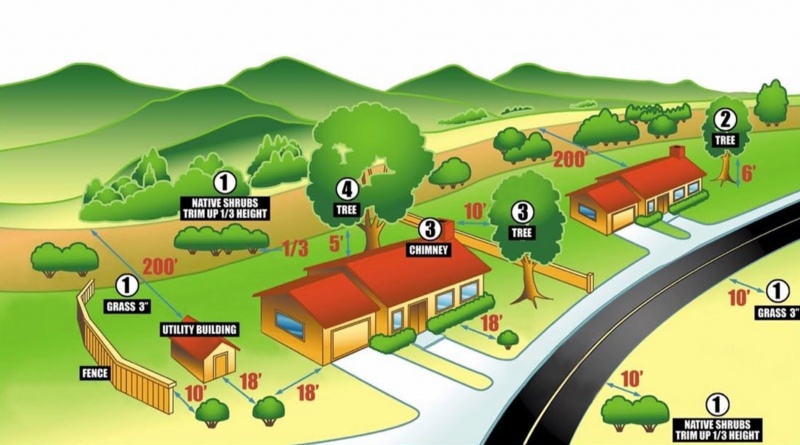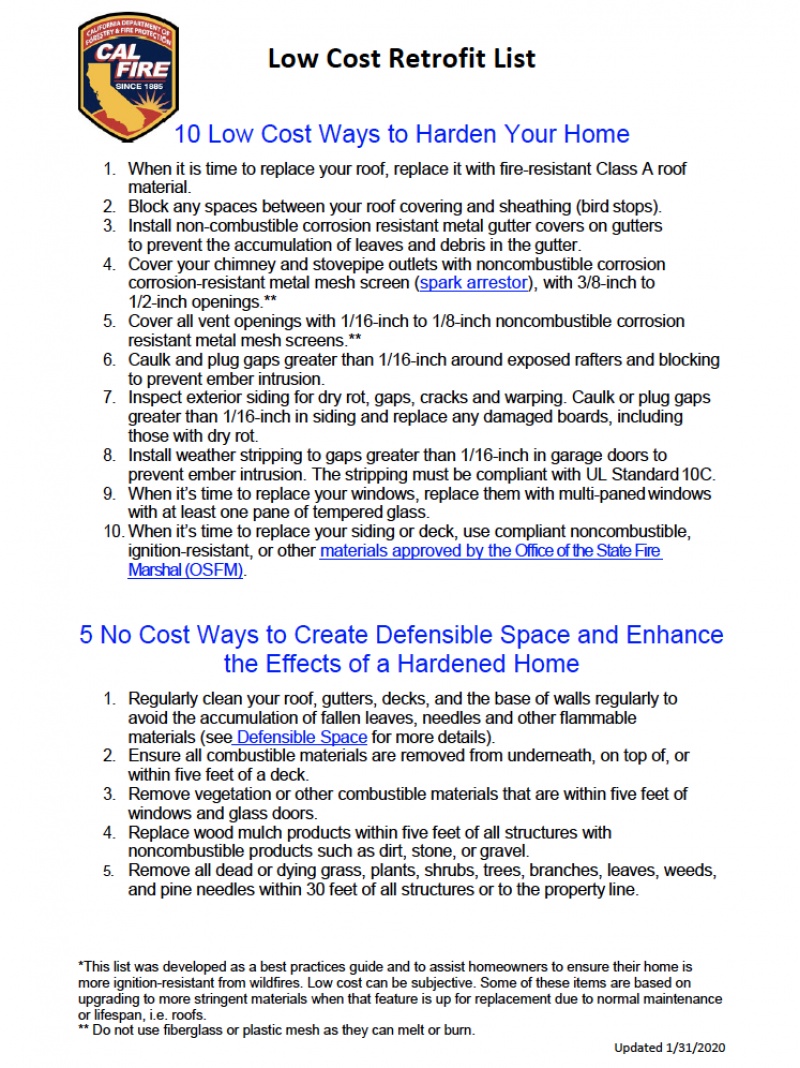Sunland-Tujunga Neighborhood Council
WILDFIRE PREPAREDNESS WEEK - CREATE YOUR DEFENSIBLE SPACE
Posted on 05/05/20
More updates 5/7/20
Hello, everyone. I hope you continue to stay safe out there. As you know, this week is Wildfire Preparedness Week, and we wanted to take the opportunity to remind everyone to prepare for our upcoming fire season, particularly those of us who live in the Very High Fire Hazard Severity Zone.
Hello, everyone. I hope you continue to stay safe out there. As you know, this week is Wildfire Preparedness Week, and we wanted to take the opportunity to remind everyone to prepare for our upcoming fire season, particularly those of us who live in the Very High Fire Hazard Severity Zone.
HARDENING YOUR HOME
Flying embers from a wildfire can destroy homes up to a mile away. Taking the necessary measures to harden (prepare) your home can help increase its chance of survival when wildfire strikes. You can see a quick PSA on the subject at: https://www.youtube.com/watch?time_continue=30&v=jYXTAhmJsVQ&feature=emb_logo.
Here are ways you can harden your home and make it more fire resistant:
Roof
The roof is the most vulnerable part of your home. Homes with wood or shingle roofs are at high risk of being destroyed during a wildfire. Build your roof or re-roof with materials such as composition, metal or tile. Block any spaces between roof decking and covering to prevent embers from catching.
Vents
Vents on homes create openings for flying embers.
Eaves and soffits should be protected with ignition-resistant* or non-combustible materials.
Windows
Heat from a wildfire can cause windows to break even before the home is on fire. This allows burning embers to enter and start fires inside. Single-paned and large windows are particularly vulnerable.
Wood products, such as boards, panels or shingles, are common siding materials. However, they are flammable and not good choices for fire-prone areas.
Surfaces within 10 feet of the building should be built with ignition-resistant*, non-combustible, or other approved materials.
Keep rain gutters clear or enclose rain gutters to prevent accumulation of plant debris.
Patio Cover
Use the same ignition-resistant* materials for patio coverings as a roof.
Chimney
Cover your chimney and stovepipe outlets with a non-flammable screen. Use metal screen material with openings no smaller than 3/8-inch and no larger than 1/2-inch to prevent embers from escaping and igniting a fire.
Garage
Have a fire extinguisher and tools such as a shovel, rake, bucket, and hose available for fire emergencies.
Consider using ignition-resistant* or non-combustible fence materials to protect your home during a wildfire.
Driveways and Access Roads
Driveways should be built and maintained in accordance with state and local codes to allow fire and emergency vehicles to reach your home. Consider maintaining access roads with a minimum of 10 feet of clearance on either side, allowing for two-way traffic.
Make sure your address is clearly visible from the road.
Water Supply
Consider having multiple garden hoses that are long enough to reach all areas of your home and other structures on your property. If you have a pool or well, consider getting a pump
*Ignition-resistant building materials are those that resist ignition or sustained burning when exposed to embers and small flames from wildfires. Examples of ignition-resistant materials include “non-combustible materials” that don’t burn, exterior grade fire-retardant-treated wood lumber, fire-retardant-treated wood shakes and shingles listed by the State Fire Marshal (SFM) and any material that has been tested in accordance with SFM Standard 12-7A-5.
Flying embers from a wildfire can destroy homes up to a mile away. Taking the necessary measures to harden (prepare) your home can help increase its chance of survival when wildfire strikes. You can see a quick PSA on the subject at: https://www.youtube.com/watch?time_continue=30&v=jYXTAhmJsVQ&feature=emb_logo.
Here are ways you can harden your home and make it more fire resistant:
Roof
The roof is the most vulnerable part of your home. Homes with wood or shingle roofs are at high risk of being destroyed during a wildfire. Build your roof or re-roof with materials such as composition, metal or tile. Block any spaces between roof decking and covering to prevent embers from catching.
Vents
Vents on homes create openings for flying embers.
- Cover all vent openings with 1/16-inch to 1/8-inch metal mesh. Do not use fiberglass or plastic mesh because they can melt and burn.
- Protect vents in eaves or cornices with baffles to block embers (mesh is not enough).
Eaves and soffits should be protected with ignition-resistant* or non-combustible materials.
Windows
Heat from a wildfire can cause windows to break even before the home is on fire. This allows burning embers to enter and start fires inside. Single-paned and large windows are particularly vulnerable.
- Install dual-paned windows with one pane of tempered glass to reduce the chance of breakage in a fire.
- Consider limiting the size and number of windows that face large areas of vegetation.
Wood products, such as boards, panels or shingles, are common siding materials. However, they are flammable and not good choices for fire-prone areas.
- Build or remodel your walls with ignition resistant* building materials, such as stucco, fiber cement wall siding, fire retardant, treated wood, or other approved materials.
- Be sure to extend materials from the foundation to the roof.
Surfaces within 10 feet of the building should be built with ignition-resistant*, non-combustible, or other approved materials.
- Ensure that all combustible items are removed from underneath your deck.
Keep rain gutters clear or enclose rain gutters to prevent accumulation of plant debris.
Patio Cover
Use the same ignition-resistant* materials for patio coverings as a roof.
Chimney
Cover your chimney and stovepipe outlets with a non-flammable screen. Use metal screen material with openings no smaller than 3/8-inch and no larger than 1/2-inch to prevent embers from escaping and igniting a fire.
Garage
Have a fire extinguisher and tools such as a shovel, rake, bucket, and hose available for fire emergencies.
- Install weather stripping around and under the garage door to prevent embers from blowing in.
- Store all combustible and flammable liquids away from ignition sources.
Consider using ignition-resistant* or non-combustible fence materials to protect your home during a wildfire.
Driveways and Access Roads
Driveways should be built and maintained in accordance with state and local codes to allow fire and emergency vehicles to reach your home. Consider maintaining access roads with a minimum of 10 feet of clearance on either side, allowing for two-way traffic.
- Ensure that all gates open inward and are wide enough to accommodate emergency equipment.
- Trim trees and shrubs overhanging the road to allow emergency vehicles to pass.
Make sure your address is clearly visible from the road.
Water Supply
Consider having multiple garden hoses that are long enough to reach all areas of your home and other structures on your property. If you have a pool or well, consider getting a pump
*Ignition-resistant building materials are those that resist ignition or sustained burning when exposed to embers and small flames from wildfires. Examples of ignition-resistant materials include “non-combustible materials” that don’t burn, exterior grade fire-retardant-treated wood lumber, fire-retardant-treated wood shakes and shingles listed by the State Fire Marshal (SFM) and any material that has been tested in accordance with SFM Standard 12-7A-5.
Please share out this message through all of your networks, as it is imperative to communicate this message widely to increase our fire safety here in Council District 7. As we continue to shelter at home, now is a great time to take simple steps that will help your house survive a potential wildfire, such as clearing out rain gutters, removing any combustible materials from around your house or deck, making sure your address is visible from the road, and considering upgrades to ignition-resistant materials during maintenance of your home. For mandatory brush clearance requirements in the Very High Fire Hazard Severity Zone, go to the LAFD Brush website: https://www.lafd.org/fire-prevention/brush/brush-clearance-requirements.
More to come throughout this week.... Thank you, and take care!
Hello, everyone.
I hope you are all staying safe out there. This week is Wildfire Preparedness Week, and we wanted to take the opportunity to remind everyone to prepare for our upcoming fire season, particularly those of us who live in the Very High Fire Hazard Severity Zone. We have already seen a couple of small brush fires occur in our district, such as the one in Shadow Hills yesterday that burned two acres of brush and originated from an outdoor welding operation. Thankfully, our Los Angeles Fire Department was able to quickly extinguish that brush fire.
While we are all staying Safer at Home during this pandemic, this is a great time and opportunity to create defensible space, by clearing debris away from our houses, trimming back excess vegetation, and proactively preparing our properties and ourselves for the upcoming fire season, which is anticipated to be even more severe than the last one. We will be sharing messages throughout this week on preparing for wildfire (creating defensible space, hardening your home, and installing fire-resistant landscaping), preventing wildfire (through responsible equipment and vehicle use), and preparing a handy evacuation guide (to be used in the event of wildfire).
Please share out this message through all of your networks, as it is imperative to communicate this message widely to increase our fire safety here in Council District 7. For mandatory brush clearance requirements in the Very High Fire Hazard Severity Zone, go to the LAFD Brush website: https://www.lafd.org/fire-prevention/brush/brush-clearance-requirements. You can also view the 2020 Cal Fire Defensible Space PSA at: https://www.youtube.com/watch?v=uawt5fTLU6Q, and learn more about guidelines for successfully creating and increasing your defensible space at: https://www.readyforwildfire.org/prepare-for-wildfire/get-ready/defensible-space/.
More to come throughout this week.... Thank you, and take care!
Eve Sinclair, Area Director
Councilwoman Monica Rodriguez, 7th District
13520 Van Nuys Blvd. Suite 209, Pacoima, CA 91331
Phone: 818-485-0600 Fax: 818-896-9250
www.monicarodriguez.org
Download Low-cost-Retrofit-List-Final.pdf

Upcoming Meetings & Events

 MENU
MENU









